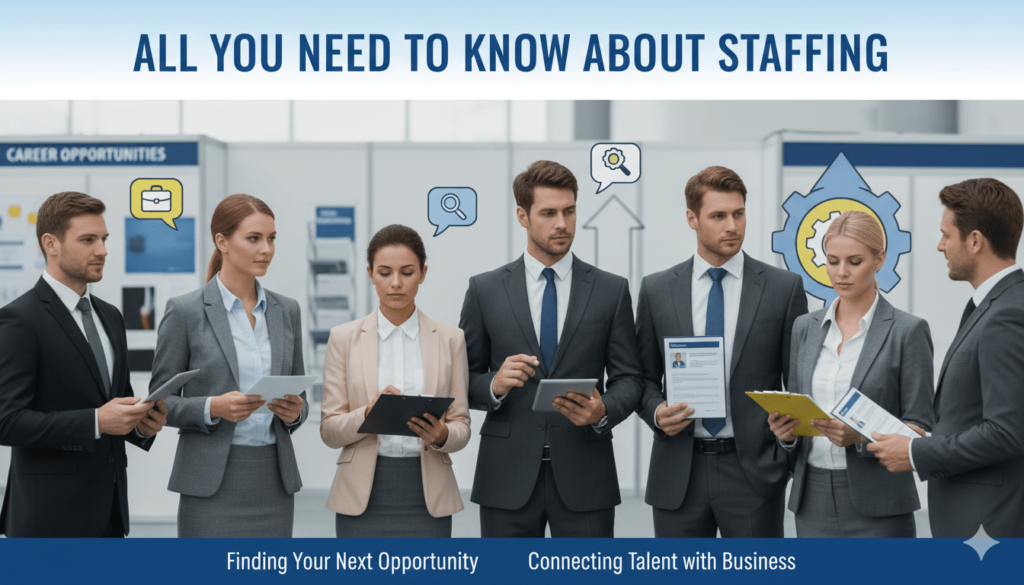
Staffing is the ongoing process of having the right people in the right place at the right time. It encompasses everything from predicting to employing, mastering, and fair pay. Done well, staffing keeps processes flowing, reduces roadblocks, and drives growth without burning people out. To a business, it’s the day-to-day machinery of people management – practical, measurable, and directly tied to results.
What Is Staffing?
This is a process of management that hires, deploys, and keeps workers so the company can accomplish its goals. It involves workforce planning, recruiting, selection, placement, training, appraisal, and promotion. Whereas recruiting focuses on sourcing and attracting talent, staffing takes the whole cycle into account and how jobs are intermeshed. And while HR sets up policies, benefits, and compliance, staffing turns those frameworks into actual teams that can get the job done. Staffing connects business plans to human potential, and then adapts as situations change. It connects these parts to outcomes: consistent performance and reliable coverage across teams. (And if you’re curious, what is a staffing agency? It’s simply a third party that helps companies fill roles.)
Main Functions of Staffing
Staffing is a cyclical process that continues to keep people in the proper positions as situations change. The functions below work together, from planning headcount to growing and rewarding talent. Use them as building blocks you can scale and tailor to your team:
- Workforce planning. Project headcount and skills by team and time frame; reconcile budgets to requirements.
- Recruitment. Attract suitable applicants with clear roles, fair pay ranges, and honest indicators of culture. Attempt internal mobility first.
- Selection. Assess skills and behavior with standardized interviews, work samples, and established tests to reduce bias and guesswork.
- Orientation and placement. Give new employees context, tools, and a supportive manager; match strengths with jobs starting week one.
- Training and development. Build job skills and future skills through classes, mentoring, and stretch assignments. Also see our training programs.
- Performance evaluation. Use consistent goals, ongoing feedback, and recorded results to spur pay, growth, and coaching.
- Compensation and promotion. Pay for influence and results, not quantity. Clarify salary bands and promotions by establishing clear criteria.
Each function feeds the next. When these steps work on a reliable beat, high-quality hiring rises, ramp-up time shortens, and teams continue to be productive.
Types of Staffing
The majority of companies apply a blend of approaches: promote internal talent and transfer people between groups, recruit externally to backfill new skills, and hire temps or contractors for one-offs or bursts. They match that blend to budget, hiring speed, and risk appetite. And when they want expert help, they often search for what are staffing companies and hand off parts of the hiring process to outside specialists. They maintain candidate pools and match talent to client needs on agreed-upon terms. You can choose the mix that meets your speed, budget, and risk requirements.
Importance of Effective Staffing
Effective staffing increases outcomes in the ways teams feel daily:
- Operation flow. Fewer coverage gaps, smoother transitions, and higher cycle times.
- Quality and safety. Better matches reduce rework, burnout, and errors.
- Engagement. People who see opportunity for growth stay longer and contribute more.
- Cost control. Strategic hiring beats crisis searching and overtime.
- Flexibility. Open skills data enables you to move talent in response to changing priorities.
Link these advantages to business goals with user-friendly metrics: time to fill, quality of hire, first-year retention, internal mobility rate, and manager satisfaction.
Final Thoughts
Staffing is the catalyst for people operations, turning business strategy into real teams that deliver. If you treat it like a rolling, strategic process, you drive performance, guard culture, and stay ahead of change. The payoff is simple: better fits, bigger results, and an employee base that compounds with your ambitions.

